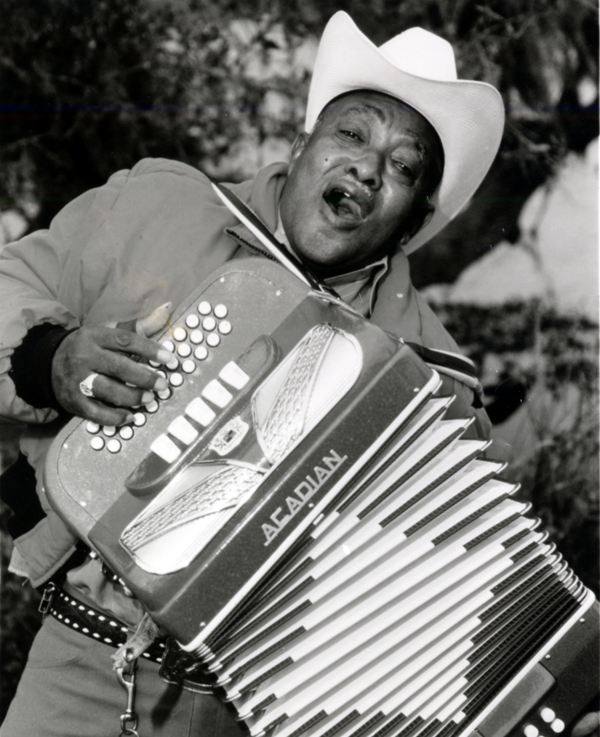Boozoo Chavis
Wilson Anthony "Boozoo" Chavis was a pioneering zydeco musician best known for highly danceable tunes and his often-risqué sense of humor.

Louisiana State Museum
Boozoo Chavis playing the accordion.
Boozoo Chavis, one of the pioneers of zydeco music, is best known for his highly danceable tunes and risqué sense of humor. His 1954 recording of “Paper in My Shoe” is generally cited as the first zydeco recording. Though the record was a hit, Chavis left the music business for about 30 years, citing unfair business practices as the reason for his exit. His unique style of playing zydeco music—featuring a diatonic accordion backed by guitars and drums—undeniably shaped the musical genre.
Born on October 23, 1930, in Dog Hill, a small community near Lake Charles, Wilson Anthony “Boozoo” Chavis hailed from a musical family. His father played accordion at local dances, and his mother was part of the Babineaux family, which included Chavis’s great-uncle Sidney Babineaux, a famed accordionist. Babineaux was one of the earliest Creole musicians to play the piano accordion and often performed with pioneering Cajun musician Joe Falcon. During the 1940s, Chavis began playing creole dances. Held in private homes or dance halls, these dances were referred to as la las—a term that means “to put to sleep”—because parents had to put their children to sleep before they could dance. When not playing music, Chavis worked as a cowboy, jockey, and horse trainer.
In 1954, Lake Charles producer Eddie Shuler of Goldband Records wanted to record a creole musician for his Goldband label. Cajun accordionist and instrument builder Sidney Brown told Shuler about Chavis. Shuler auditioned Chavis and hired Classie Ballou’s rhythm and blues (R&B) band to accompany him on the record. The resulting session was chaotic. The band did not know how to back Chavis, who was well known for “breaking time.” The resulting tracks reveal an unresolved tension between Chavis’s accordion style and the band’s spirited R&B style.
Rumors also spread that Chavis got drunk during the session and fell from his stool while still playing the accordion. Chavis denied the story in later years, but it has remained an enduring part of zydeco folklore. Goldband released “Paper in My Shoe” from the session and became locally popular. The record is generally accepted as the first zydeco recording, but the exact date of the session is unknown. However, Goldband also recorded Clarence Garlow’s “Za Belle” in the same year and its release number indicates that it came out before the Chavis record.
Chavis continued working with Shuler for several years but soon tired of hectic touring and what he felt were unfair business practices in the music industry. In the early 1960s, he left the professional music field and returned to training racehorses. He remained popular with locals, however, and played occasional dances and trail rides.
In 1984 his wife, Leona Predium Chavis, pushed Chavis to reenter the zydeco scene professionally. The music was growing in popularity and gaining a national reputation. Most audiences were familiar with Clifton Chenier’s urban style of zydeco, featuring a piano accordion backed with a full R&B band that included a front line of horns and a rub board. In contrast, Chavis performed in a rural style with a diatonic accordion backed by guitars and drums. He focused heavily on the beat, pounding out a driving dance groove that often wore out the dancers. His lyrics were simplistic and often highly repetitive, yet there was no doubt that Chavis’s music was good dance music. Extremely popular on the national folk circuit, he was well known for his highly risqué versions of “Uncle Bud” and “Deacon John.” These records were sold “under the counter” in regional record shops. In 1999 Chavis released new versions of the songs on his compact disc Who Stole My Monkey. The disc garnered the dubious honor of being the first Cajun or zydeco record to carry a parental warning label due to the offensive lyrics.
Chavis recorded regularly during the 1980s and 1990s. His finest records were with the prestigious Rounder label. Studio recordings seldom captured the full fire of Chavis, and, as result, his style is best heard on live recordings such as “Live! At the Habibi Temple, Lake Charles, Louisiana” and “Zydeco Live,” which includes a live performance by Nathan and the Zydeco Cha Chas. On the live sets, Chavis’s burning and extended dance grooves shine and the exuberant crowd can be heard urging him to play.
Following the death of Clifton Chenier, the zydeco community entered a fierce period when various artists vied for the title of “King of Zydeco.” Chavis was crowned in 1994, an event that precipitated a series of good-natured battle of the bands with other artists. The first of these occurred in New Orleans at the Rock’n’Bowl with Beau Jacque challenging Chavis. The “rivalry” between the two lasted until Jacque’s unexpected death in 1999. Chavis faced many challengers in battles of the bands over the remaining years of his life, usually winning. Many of the younger artists viewed battling him—and losing—as a rite of zydeco passage. By the 1990s, his style of rural zydeco based around the diatonic accordion and stage dress featuring cowboy clothes had supplanted the urban style. There were several reasons for this, including Chavis’s personality, but the diatonic accordion lent itself easily to the rhythmic styles younger artists desired as they fused hip-hop and rap with zydeco. Indeed, Chavis had foreshadowed this move with his risqué hit “Boozoo’s Blue Balls Rap.” After his death in 2001, the concept of a “king” of zydeco faded, perhaps a tribute to one of the genre’s last founding fathers.
